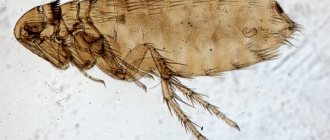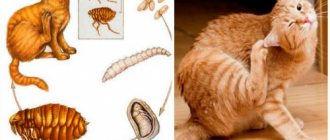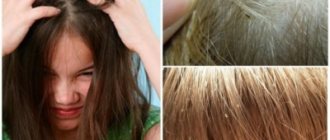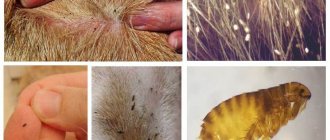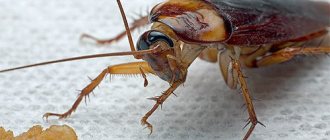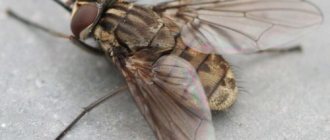Features of chicken lice
Chicken lice are parasites that can live for a long time and also actively reproduce on the bird’s body. They feed on its blood, fragments of skin, down or feathers. These parasites can be located in entire colonies on the skin and plumage of a chicken. In addition, they have about 40 species.
This external parasite has a special structure:
- body small, flattened;
- the head is disproportionately large, equipped with chewing-type jaws;
- three or five-part whiskers.
On average, the louse reaches more than 1-5 mm in length. The formation of a new sexually mature individual occurs in 3-4 weeks, depending on temperature conditions. From the nits that adults lay on feathers, the young appear in 4-7 days, which indicates that the chicken louse reproduces quickly.
Spread of parasites and danger to other animals and people
A chicken louse can bite a person and even stay on his body for some time, but it cannot live and reproduce there for a long time. As for other animals, it depends on the type of insect, since a variety of types of these pests can parasitize on one body. Unlike fleas, chicken lice can be easily removed from hair by simply washing your hair, but this does not mean that contact with them is completely safe.
Feeding on the host's blood, the insect secretes a special liquid that prevents the blood in the wound from clotting. This causes discomfort in the bird, and can also contribute to infection with infectious diseases that are transmitted directly by lice. Parasites almost always appear in chickens that are kept in unsanitary conditions. This further increases the chance of contracting various diseases.
As mentioned above, chicken lice can greatly slow down weight gain in young birds, reduce it in adults, and also reduce the quality of meat and eggs. In addition, the bite of such a parasite can be not only very painful, but even dangerous. Among the diseases transmitted to humans directly or through consumption of contaminated meat, four main ones can be distinguished:
- encephalitis;
- salmonellosis;
- brucellosis;
- helminthiasis
It is also worth noting the possibility of an allergic reaction to a bite. You should be especially careful when cleaning areas where infected chicken was kept, and it is better to think about timely prevention of the disease.
Damage from parasites to birds
When a chicken louse gets on the skin of a bird, it begins to actively feed on its blood. The chickens become very irritated. They begin to itch a lot and also pluck feathers from all available places.
When the number of pests becomes critically large, the chickens stop laying eggs and practically do not move. Over time, they may become anemic and completely exhausted.
In addition, these ectoparasites can infect chickens with severe infectious diseases: brucellosis, salsalmonellosis, trypanosomiasis, mycoplasmosis, plague, encephalitis.
Against this background, not only chickens, but also their owners can suffer.
Lice and lice
Chicken mallophages or chicken lice eaters are small insects that parasitize birds. They are keratophages and feed on the keratin of bird hair. Externally, lice and lice are very similar, which is why the people call lice “chicken louse”.
However, despite the external similarity, lice and lice differ in feeding habits. Lice feed mainly on blood, while lice eat feathers and down. In veterinary practice, infection of birds by lice eaters is called mallophagosis. This disease is quite often diagnosed in domestic chickens.
You can assume that a chicken has lice eaters based on the following signs:
- On physical examination of the bird, damage to the feathers at the root is observed.
- The chicken is acting very restless. She constantly tries to clean her feathers of parasites with her beak.
- If there are too many parasites, partial loss of feathers may occur.
If chickens are infected with lice beetles, their ability to lay eggs will be significantly reduced.
In addition, the birds will stop gaining weight or even begin to lose weight.
What do feather eaters and lice eaters look like in chickens?
Both types of insects are small parasites that settle in the thickness of the plumage and under it. The parasites' diet includes the top layer of skin and particles of the base of feathers. As a rule, there are no problems with the detection of feather and lice beetles. The easiest way to visualize them is on the head of a calmly sitting bird.
Features of the external structure of feather and lice eaters:
- fast movement;
- yellowish or light brown flat body;
- average length – 2 mm yellowish or brownish color;
- rapid generation of new generations. It happens that there are 10,000 parasitic insects on one small bird;
- resistance to temperature changes;
- can go hungry for a long time.
- It takes up to three weeks for the eggs of periodeaters to mature.
How to remove lice from chickens
To get rid of lice, it is necessary to treat the chickens and the room where they are kept. Inexperienced poultry farmers often do not know how to best treat chickens, so they waste time using various ineffective methods.
Experienced farmers can share their experience on how to rid domestic chickens of lice using folk methods or chemicals. Whichever method is preferred, they recommend processing the birds twice.
Repeated treatment is usually carried out 7 days after the initial one.
Chemicals
When it is necessary to treat chickens for lice, it is very important to select products that will not harm the birds. Numerous veterinary insecticides cope well with this task.
The most effective drugs of this type are:
- Insectoacaricidal powder. Poultry farmers appreciate it for its ease of use. It is enough to apply 1-5 g of the product to the feathers and a pronounced therapeutic effect will not take long to appear.
- Frontline, Beafar. Some farmers prefer such medicines in spray form. Therapeutic manipulation involves spraying the wings of the affected chickens so much that they become wet.
- Promectin. This drug is intended for oral use. It is usually added to the drinking water that chickens consume daily. Most often, this remedy is used to treat young animals and eliminate lice in broiler chickens.
- Butox. Another dosage form option is dry powder. A solution is prepared from it, intended for treating infected birds.
- Neostomazan, Stomazan or 2% oxamate emulsion. Quite effective means, but they are contraindicated for laying hens or those chickens that will soon be sent for slaughter. This is due to the fact that their active ingredients (insecticides) can persist for some time in poultry meat or eggs.
Most properly selected veterinary drugs, when used correctly, do not contribute to poultry poisoning and the accumulation of poisons in its meat or eggs. If desired, poultry farmers can choose the optimal form of insecticide (drug solutions, sprays or powders) for their chickens.
It is recommended to remove lice from chickens with Butox 50. One dose of the product is dissolved in 4 liters of water. It is imperative to maintain the dosage so as not to harm the chickens. And the person who will do the processing must first put on gloves and a respirator.
Spray the chickens generously with the resulting solution. It is more correct to catch each chicken separately and cover their head while spraying. During manipulation, special attention should be paid to the neck, abdomen and areas under the wings.
When spraying insecticide, it is important to ensure that the product does not get into the beak or eyes.
It is also necessary to treat adult individuals so that in the future the chicks do not become infected again after contact with them. If such drugs are not at hand, as a last resort, you can use flea drops - Celandine, Dana, Bars.
The dosage should be selected based on the weight of the bird and applied to the skin of the chicken. However, it should be remembered that such insecticides do not kill parasite eggs.
Folk remedies
The fight against chicken lice can be done at home using traditional methods.
The lice and feather eater in chickens can be successfully eliminated using the following means:
- Kerosene kills adult lice and partially dissolves chitin in larvae. Infected chickens are treated with kerosene, after which they are quarantined in a separate room. After 7 days, the treatment is repeated.
- To combat nits, lice treatments should include vinegar. Before use, dilute 1 part vinegar with 1.5 parts water. The prepared solution is used to treat the skin and feathers of chickens. Repeated manipulation is performed a week later.
- Some poultry farmers note that tar helped them in the fight against lice. They diluted it with sunflower oil (1:1) and smeared it on the chickens.
- Baths made of sand and ash can be a preventive or additional method of control. It is recommended to rub this composition into the fluff. Or place basins with ash and sand in the chicken coop so that the chickens can give themselves baths.
In addition, medicinal plants that repel them can help in the fight against lice: wormwood, marsh rosemary, tansy. It is recommended to hang bunches of such herbs in the chicken coop or place them in the bedding.
This method is good for preventative purposes, after the birds and their habitat have been treated to kill parasites.
Video
BioVax spray lotion. Prevention and treatment of birds. Anti-parasite spray
How do parasites spread?
Lice in chickens are down-eaters; they are small parasites that belong to the group of mallophages. Insects lead a parasitic lifestyle on domestic and wild birds. Pediculosis in birds is caused by one representative of the group - the chicken louse. The insect affects not only birds kept in the barn, but also those that spend most of their time walking. The disease can affect not only individual individuals, but also numerous populations. The main reasons for the spread of chicken parasites:
- vitamin deficiency, poor quality nutrition;
- poor quality cleaning in the barn;
- damp room;
- overcrowding;
- irregular preventive treatment of the barn;
Infection of poultry can occur from wild relatives (pigeons, sparrows, swallows), which make their nests in poultry houses. Rodents and cats are also capable of carrying larvae and adult chicken parasites on their fur and paws. Owners can also be carriers; they can carry insects on shoes, things and equipment.
How to get rid of chicken lice in a chicken coop
If lice manage to infest a chicken coop, then all the birds living there will suffer. Taking this into account, treating the chicken coop for lice is mandatory. To eliminate parasites from the walls and floor of the chicken coop, it is recommended to use smoke bombs. There should be no birds in the area during processing.
The calculation of the product is as follows: 1 checker (50 g) per room of 250 cubic meters.
In addition, it is advisable to wash the entire chicken coop area with any pediculicidal solution. The walls should literally be bathed in an antiparasitic agent. In advanced conditions, it is recommended to burn the walls and floor with a blowtorch.
A week later, the treatment of the chicken coop must be repeated. After thorough treatment of the premises, they begin to remove lice from chickens.
How to deal with a feather eater
Parasites can appear in chickens even in ideal conditions for keeping the latter.
The appearance of parasites in chickens is not excluded even when the bird is kept under normal conditions. Carriers and transmitters of lice can be other inhabitants of the farm and representatives of wild fauna. Among the latter, the most common carriers are:
- sparrows,
- pigeons,
- rats.
Parasites are in constant migration and can end up anywhere and on anyone, so it is important to regularly carry out preventive measures and take immediate control measures when they are detected, even in small quantities.
Professional means of combating chicken lice
If parasites are detected in poultry, it will be necessary not only to treat the chickens, but also to disinfest the place where they live. However, before using insecticides, you should thoroughly clean the poultry house, remove litter, droppings and other traces of the life of the farm’s inhabitants.
Spray products can be divided into two safety classes. The use of some does not require the relocation of chickens, while others imply the absence of pets in the room during processing. As a rule, the latter are less expensive drugs, but this also means greater labor costs.
The first class includes:
- Entomozan S,
- other insecticides with permethrin.
The second class includes drugs such as:
- Drucker,
- Diazinon,
- Sevin,
- Stomazan,
- Digital.
Spraying the room is carried out with a solution of the drug calculated according to the instructions. On average, about half a liter of the prepared composition is consumed for each square meter of the chicken coop. Specific dosages depend on the type of insecticide.
Entomozan Super contains such an active substance as permethrin
Farmers also recommend using a proven product such as an insecticidal smoke bomb to treat the poultry house. Treat the premises in the absence of chickens. One smoke bomb is usually enough to treat at least two hundred cubic meters of territory. It should be borne in mind that sulfur bombs are used to combat fungus and mold, but not for pest control.
Traditional methods
Folk remedies for treating chicken coops against parasites mainly include the use of herbs. For these purposes, the most often recommended are:
- sagebrush,
- mint,
- wild rosemary,
- tansy.
Bunches of the plants listed above hung in the poultry house work most effectively after complete disinfestation of the premises and treatment of the birds, and are excellent for preventing potential infection.
Preparing your chicken coop to combat chicken lice
If pediculosis is detected in chickens, then you need to spend a lot of time to first clean the chicken coop and kill all the parasites. First of all, poultry farmers should thoroughly clean out chicken droppings and litter residues.
Feeders, drinkers and other items used by birds also need to be thoroughly washed. When washing, you should use disinfectants, and it is also advisable to pour boiling water over them to remove nits.
If there is a pen next to the chicken coop, then it would be correct to remove the top layer of soil on it and take it away from the chicken coop. And sand and ash can be poured into its original place.
How to treat chickens for feather eaters and lice eaters
Effective chemistry! Preparations against feather and leaf eaters are available in almost all veterinary pharmacies. And, believe me, there is plenty to choose from. Below are the most popular means:
- Bars is a composition originally developed to get rid of insects from cats and dogs. At the same time, the product is of great interest to poultry farmers. Method of using the feathered one.
- Nyuda is a spray designed to combat lice in humans. The drug is also applicable to chickens and other types of poultry. This is an expensive pleasure, so purchasing such a product is justified if you have a small herd.
- Butox is a universal powder composition. After diluting with water, the product is poured into a spray bottle and applied to the feathers of the animals under care. Suitable for treating structural elements of a chicken coop (10 ml of powder + 10 l of H2O).
- Frontline is another spray that only kills adult insects. Use twice, the second time in a week.
- Insektol is a drug in the form of a spray applied to the plumage (under the tail and wings).
- Arpalit is an insecticide with a long period of action after treatment of livestock. That is, such a product eliminates the need for re-processing.
Please note that sprays are not suitable for young animals.
What does folk veterinary medicine offer? So-called ash baths are installed in the poultry house and outside it, in which the bird cleans its plumage. Baths with the following composition also help: kerosene + water + vinegar.
After establishing the fact of the problem, you can use a remedy that includes ammonia, kerosene and benzene. Feather and lice eaters flee even from the smell alone. In the form of powder, a mixture of white hellebore root and leafless barnacle branches is applied to the affected bird. This composition is poisonous. Therefore, you should not abuse it.
Some experienced poultry breeders include chamomile, tansy, and wild rosemary in the bedding material.
Answers to popular questions
Inexperienced poultry keepers can be very confused when parasites appear in the area where the chickens are kept or on the birds themselves. Experienced veterinarians and farmers can tell you why lice appear and how to deal with them.
Where do lice come from?
The main reasons for the appearance of chicken lice:
- the coop room is too humid;
- litter is rarely removed from the chicken coop;
- chickens on dirty bedding get sick faster;
- the owners do not take good care of the chickens;
- the chicken coop is too small, cramped;
- the room where chickens are kept is never treated with disinfectants.
Sometimes lice appear even in clean and well-kept chicken coops. Sometimes they are brought there by foreign birds who want to profit from the feeder. Parasites from an infected bird spread to a healthy one, after which a dynamic process of reproduction in the feathers begins.
It is important to identify the pathological process at the initial stage, since advanced chicken lice is very difficult to treat.
What does a chicken louse look like?
It is not easy to see an insect on a chicken without special preparation. But a poultry farmer may have a general idea of what a chicken lice looks like. This ectoparasite is usually brown in color. Its length can be 1.5-2.5 mm.
The louse has a disproportionate figure. The head is slightly larger than the body. The louse is localized mainly on the skin. It lays nits at the base of feathers.
To identify the parasite at the initial stage, a special procedure of heating the chicken for 10 minutes is used. After such manipulation, the insects crawl onto the surface of the feather.
How to recognize lice in birds, symptoms of infection
Parasites can attack chickens of all ages, but the younger generation of birds suffers the most from them. Carnivores are carried by infected pets; pests can be found on care items and equipment. Lice can be found in nests, dust baths and cages. Their most active carriers are roosters, since they bathe little in sand and dust baths and are less likely to clean their plumage.
The number of infections typically increases sharply in the fall and spring. This is also facilitated by factors such as:
- chicken coop overpopulation,
- large crowd of birds,
- wrong content,
- insufficient care
- poor nutrition,
- dampness and dirt in the chickens' home.
Signs of the presence of lice eaters in a bird can be seen with the naked eye, these are, first of all:
- combing,
- baldness, most often in the back, neck, abdomen,
- holes in the feather
- bird anxiety, inappropriate behavior,
- pecking,
- feather plucking,
- abrasions and damage,
- inflammation of the eyes,
- poor egg production,
- weight loss.
Several types of pests can be present on one pet at once. Some lice eaters prefer to settle in the feather cover under the wings, others choose the neck and head. The chicken louse prefers young feathers, which is why the activity and number of parasites increases during the molting period. On the bare skin of a bird with severe infection, wounds that appear as a result of scratching, as well as parasite eggs, are clearly visible. Similar signs are observed on the earrings and comb of pets.
You can diagnose a periodontal infestation by carefully examining the bird.
Diagnosing the presence of a problem in chickens is quite easy. To do this, place the bird in the sun or under the light of an incandescent lamp. Within a few minutes, the parasites crawl into the heat and become clearly visible to the naked eye. Using this method, you can more or less accurately determine the extent of the infection. Dead chickens are not of interest to feather eaters, since for a comfortable existence it is important for them to have heat and a constant temperature of a certain level.


